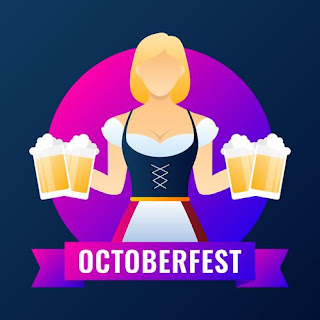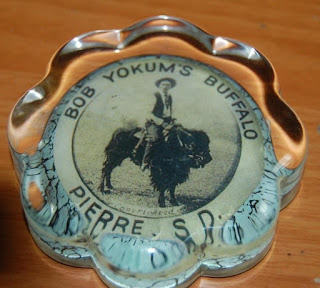Over the years of this blog I have highlighted a range of images related to beer and its advertising, including King Gambrinus, tiny angels, women sitting in moons, and motorists imbibing. Octoberfest 2018 provides an opportunity to review the depiction of the barmaid — she of the dirndl dress and the foaming steins of brew. You may call it a stereotype of the female, but the reality has brought joy to the hearts of many.
In 1912, for example, the U.S. Brewer’s Association held it 26th annual convention in Cleveland. Conventioneers were given a clothes brush for the men, shown left, and a pocket mirror for their wives, right. Both items featured an illustration in celluloid of a barmaid balancing on a barrel while carrying eight steins of foaming beer. These souvenirs were a gift to the brewmasters from the Cleveland Brewers Supply Co. a business that provided breweries with everything from barrel washers, barrel hoops, gauges, hop separators, and keg scrubbers to a range of chemicals, Irish moss and isinglass.
 The image of a barmaid dancing on a beer barrel would have been familiar to the beer crowd. The Fred Sehring Brewery of Joliet, Illinois, commissioned from ceramics merchant Hugo Theumler of Pittsburgh a beer stein for 1900 that emphasized a calendar for the year, flanked by two figures. The elaborate label includes, as shown here, a woman whose twisted body indicates a flamboyant mood as she lifts high a foaming goblet while straddling a wooden keg.
The image of a barmaid dancing on a beer barrel would have been familiar to the beer crowd. The Fred Sehring Brewery of Joliet, Illinois, commissioned from ceramics merchant Hugo Theumler of Pittsburgh a beer stein for 1900 that emphasized a calendar for the year, flanked by two figures. The elaborate label includes, as shown here, a woman whose twisted body indicates a flamboyant mood as she lifts high a foaming goblet while straddling a wooden keg.  Bock beer often used a winsome bar maid in its advertising, usually in the company of the traditional goat, a symbol for the darker brew. The dance theme is carried forward in a poster of an 1880s vintage that features a pretty waitress, with overflowing tankards in hand, dancing on a beer barrel with a very attentive goat . No brewery is mentioned.
Bock beer often used a winsome bar maid in its advertising, usually in the company of the traditional goat, a symbol for the darker brew. The dance theme is carried forward in a poster of an 1880s vintage that features a pretty waitress, with overflowing tankards in hand, dancing on a beer barrel with a very attentive goat . No brewery is mentioned. The dance theme is repeated in an 1880s bock trade card shows a goat dancing with a girl, both of them brandishing beer glasses, while a second goat plays the fiddle. These goats conjure up the image of the satyr, the Roman mythical half man/half goat who frequently is seen in erotic juxtaposition with attractive, loosely clad or nude women.
The dance theme is repeated in an 1880s bock trade card shows a goat dancing with a girl, both of them brandishing beer glasses, while a second goat plays the fiddle. These goats conjure up the image of the satyr, the Roman mythical half man/half goat who frequently is seen in erotic juxtaposition with attractive, loosely clad or nude women. The final bock card clearly is meant to be humorous as goat bowls over a black waiter who had been carrying a full tray of drinks. In his charge the animal has missed the barmaid who is carrying a full tray of steins, filled to the brim with foaming dark beer. The card exhibits the ability of the Baltimore lithographic company that created it to execute a cartoon in many vivid colors.
The final bock card clearly is meant to be humorous as goat bowls over a black waiter who had been carrying a full tray of drinks. In his charge the animal has missed the barmaid who is carrying a full tray of steins, filled to the brim with foaming dark beer. The card exhibits the ability of the Baltimore lithographic company that created it to execute a cartoon in many vivid colors.
Even the Europeans fancy their barmaids on barrel. Below are labels for two varieties of Holsten Beer, a product of Hamburg, Germany. This brewery, acquired by the Carlsberg Group in 2004, was found in 1879. It currently owns seven breweries in Germany. Early in the 20th Century it made a foray into England by buying the Union Brewery on the south bank of River Thames. The outbreak of World War One and anti-German sentiment in Jolly Old caused it to fail.
St. Pauli Girl beer traditionally has been represented by a barmaid in dirndl. The brand derives its name from the fact that the original brewery, which was established in 1857 by Lüder Rutenberg, was located next to the former St. Paul's Friary in Bremen. Seen below are a vintage label together with a modern version. Today St. Pauli Girl is located within Beck’s Brewery in Bremen.
 A French version of the barmaid gave her a tall hat. She appears on a label of Biere Francaise, apparently brewed in Nantes, a city I once found by mistake, having been routed off main roads by the Tour de France. This brew apparently took a Gold Medal at the Paris Exposition of 1900. It may have been the only beverage in the category since it apparently non-alcoholic.
A French version of the barmaid gave her a tall hat. She appears on a label of Biere Francaise, apparently brewed in Nantes, a city I once found by mistake, having been routed off main roads by the Tour de France. This brew apparently took a Gold Medal at the Paris Exposition of 1900. It may have been the only beverage in the category since it apparently non-alcoholic.
This field trip to review barmaids of the ages ends with four photographic trade cards of a comely young woman who in series is pouring a beer, lifting a stein, sipping a sample, and raising “Prost” to the crowd. A saucy lass, she was a feature of the Falstaff Brewery, so named in 1903 after the Shakespearean character, Sir John Falstaff. Production of Falstaff Beer peaked in the mid 1960s and then steadily fell over ensuing years. The brand went out of production in 2005.
In ending this tribute to the barmaid, it seems only fitting to devote this post to Mitzi, my favorite barmaid. Holding forth at the Trail’s End Lodge on Vliet Street in Milwaukee, Mitzi never failed to dress in dirndl and kept the beers coming as my companions and I serenaded her from a rear booth at the venerable watering hole.

















